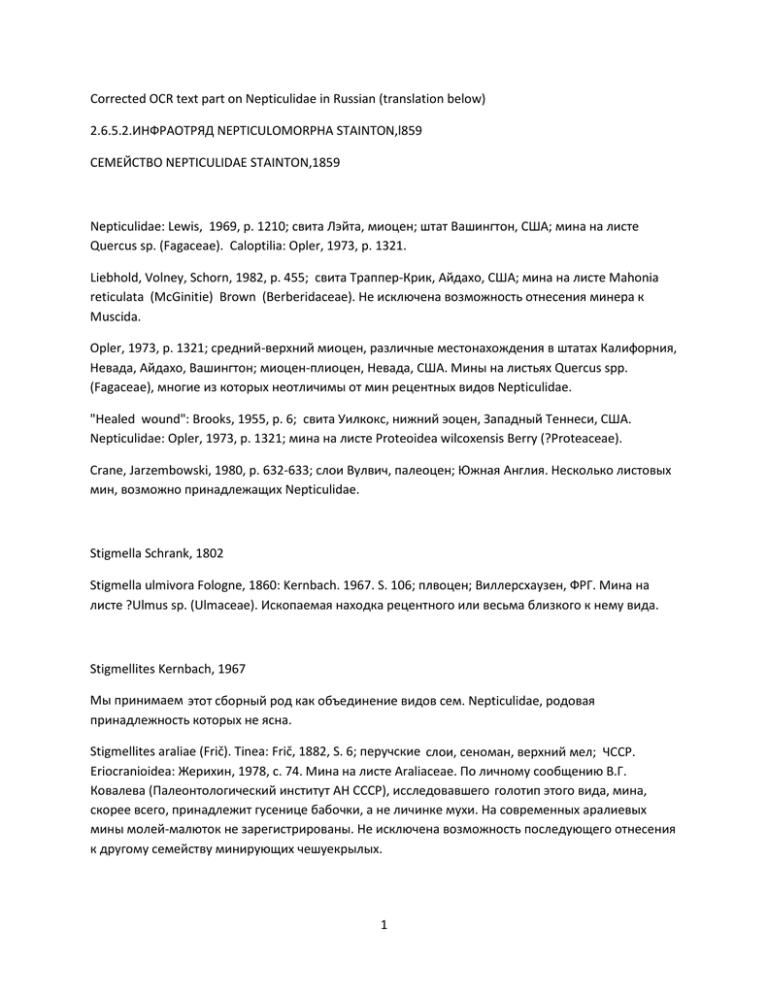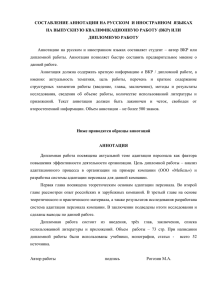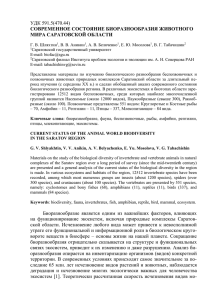2.6.5.2.ИНФРАОТРЯД NEPТICULOMORPHA STAINTON
реклама

Corrected OCR text part on Nepticulidae in Russian (translation below) 2.6.5.2.ИНФРАОТРЯД NEPТICULOMORPHA STAINTON,l859 СЕМЕЙСТВО NEPТICULIDAE SТAINТON,1859 Nepticulidae: Lewis, 1969, р. 1210; свита Лэйта, миоцен; штат Baшингтoн, CШA; мина на листе Quercus sp. (Fagaceae). Caloptilia: Opler, 1973, р. 1321. Liebhold, Volney, Schorn, 1982, р. 455; свита Траппер-Крик, Айдахо, США; мина на листе Mahonia reticulata (МcGinitie) Brown (Вerberidaceae). Не исключена возможность отнесения минера к Muscida. Opler, 1973, р. 1321; средний-верхний миоцен, различные местонахождения в штатах Калифорния, Невада, Айдахо, Вашингтон; миоцен-плиоцен, Невада, США. Мины на листьях Quercus spp. (Fagaceae), многие из которых неотличимы от мин рецентных видов Nepticulidae. "Healed wound": Brooks, 1955, р. 6; свита Уилкокс, нижний эоцен, Западный Теннеси, США. Nepticulidae: Opler, 1973, р. 1321; мина на листе Proteoidea wilcoxensis Вerry (?Proteaceae). Crane, Jarzembowski, 1980, р. 632-633; слои Вулвич, палеоцен; Южная Англия. Несколько листовых мин, возможно принадлежащих Nepticulidae. Stigmella Schrank, 1802 Stigmella ulmivora Fologne, 1860: Kernbach. 1967. S. 106; плвоцен; Виллерсхаузен, ФРГ. Мина на листе ?Ulmus sp. (Ulmaceae). Ископаемая находка рецентного или весьма близкого к нему вида. Stigmellites Kernbach, 1967 Мы принимаем этот сборный род как объединение видов сем. Nepticulidae, родовая принадлежность которых не ясна. Stigmellites araliae (Frič). Tinea: Frič, 1882, S. 6; перучские слои, сеноман, верхний мел; ЧССР. Eriocranioidea: Жерихин, 1978, с. 74. Мина на листе Araliaceae. По личному сообщению В.Г. Ковалева (Палеонтологический институт АН СССР), исследовавшего голотип этого вида, мина, скорее всего, принадлежит гусенице бабочки, а не личинке мухи. На современных аралиевых мины молей-малюток не зарегистрированы. Не исключена возможность последующего отнесения к другому семейству минирующих чешуекрылых. 1 Stigmellites baltica Kozlov, sp. nov. Голотип -N° 15-1-4 в частной коллекции К М. Садиленко, Москва; самка в балтийском янтаре; эоцен. Описание (рис. 4). Бабочка хорошо сохранилась. Чешуйчатый покров практически не нарушен, что сильно затрудняет изучение жилкования. Голова широкая, лоб выпуклый, гладкий. Усики нитевидные, поверхность члеников со взъерошенными чешуйками. Челюстные щупики длинные, 5-члениковые. Хоботок короткий, в 3 раза короче челюстных щупиков. Губные щупики не видны. Крылья узкие, с длинной бахромкой. В передних крыльях на костальный край выходят Sc и 3 ветви R, независимо отходящие от ствола R+M; Cu тонкaя. В задних крыльях различимы ствол R+M и Cu. Брюшко толстое, с вытянутым яйцекладом. Срединные шпоры на задних голенях удалены на 2/5 от основания. Длина переднего крыла 1,8 мм, ширина головы 0,45 мм, длина брюшка 1,6 мм, ширина мезонотума 0,5 мм. Размах крыльев 4,1 мм. Замечания. Это наиболее ранняя находка бабочки Nepticulidae. Сравнение описываемого вида с современными невозможно, поскольку систематика молей-малюток базируется на строении rениталий самцов. Stigmellites fossilis (Нeyden). Nepticula: Heyden, 1862, S. 77; верхний олигоцен; Зальцхаузен, ФРГ. Мина на листе Juglans acuminata Braun (Juglandaceae). ?Muscida: Opler, 1973, р. 1321; Skalski, 197За, р. 647. Принадлежность мины гусенице Nepticulidae весьма вероятна . Stigmellites heringi: KernЬach.. 1967, S. 104; плиоцен; Виллерхаузек, ФРГ. Мина на листе ?Berberis sp. (Berberidaceae). На современных видах барбарисов мины молей-малюток не отмечались; определение кормового растения нуждается в проверке. Stigmellites kzyldzharica Kozlov, sp. nov. Eriocraniidae: Жерихин, 1978, с. 79. Nepticulidae: Skalski, 1979Ь,р. 64; Жерихин,1980,с.89. Голотип - ПИН, N° 2383/206, прямой и обратный отпечатки листа Platanus sp. с миной. Паратип ПИН, N° 2383/214, отпечаток листа Platanus ambicula Vachr. с миной. Казахская ССР, КзылОрдинская обл., Чиилийский р-н, сев.-зап. отроги хребта Каратау, сопка Кзыл-Джар; белеутинская свита, турон, верхний мел. Описание (рис. 5; табл. 11, фиг. 1). Змеевидная мина на листе платана. Линия экскрементов четкая, занимает около 3/5 ширины хода. Ширина мины в дистальной части около 1,4 мм, длина мины 50-70 мм. Сравнение. В современной фауне с платанами связаны три вида молей-малюток, но их мины значительно отличаются от мины описываемого вида. Европейский Acalyptris platani (Мüller-Rutz) прокладывает змеевидную мину, причем ход целиком заполнен экскрементами (Hering, 1957). 2 Два североамериканских вида - Ectoedemia platanella (Clemens) и E. clemensella (Chambers) делают змеепятновидную мину с очень короткой змеевидной частью (Wilkinson, Newton, 1981). Stigmellites messelensis: Straus. 1976 S. 446; эоцен; Мессель, ФРГ. Кормовое растение неизвестно ("двудольное"). По-видимому, мина Nepticulidae. Stigmellites pliotityrella: Kernbach, 1967, S. 106; плиоцен; Виллерхаузен, ФРГ. Мина на листе Fagus sp. (Fagaceae). Сравнение с современными видами затруднительно. Stigmellites sp. Microlepidoptera, family uncertain, species А: Jarzembowski, 1980, р. 270; бембриджские слои, олигоцен; о-в Уайт, Англия. Форма и размеры нотумов, форма головы и жилкование крыльев однозначно определяют принадлежность этого вида к сем. Nepticulidae. Stigmellites sp. Мicrolepidoptera family uncertain, species С: Jarzembowski,1980, р. 271; бембриджские слои, олигоцен; о-в Уайт, Англия. Незначительные размеры бабочки (размах крыльев 3,8 мм) и сохранившиеся детали жилкования позволяют отнести этот вид к сем. Nepticulidae. Stigmellites serpentina Kozlov, sp. nov. Голотип - ПИН, 2383/205, отпечаток листа с 6-7 минами. Казахская ССР, Кзыл-Ординская обл., Чиилийский р-н, сев.-зап. отроги хребта Каратау, сопка Кзыл-Джар; белеутинская свита, турон, верхний мел. Описание (табл. 11, фиг. 2) Мина на листе Trochodendroides arctica Heer (Berry) (Cercidiphyllaceae). Змеевидный, сильно изогнутый ход с отчетливо выраженной линией экскрементов, занимающей 1/2-2/3 ширины хода. Апикальный участок мины без экскрементов. Ширина мины в дистальной части около 0,5 мм; длина мины 40-60 мм, длина апикального участка хода без экскрементов 3 мм. Замечания. Сем. Cercidiphyllaceae известно только в ископаемом состоянии, в связи с чем сравнение мины S. serpentina Kozlov с минами рецептных видов затруднительно. Stigmellites samsonovi Kozlov, sp. nov. Название вида в честь палеоботаника К.С.Самсонова. Голотип - ПИН, N° 2383/209, отпечаток листа с миной. Казахская ССР, Кзыл -Ординская обл., Чиилийский р-н, сев.-зап. отроги хребта Каратау, сопка Кзыл-Джар; белеутинская свита, турон, верхний мел. Описание (табл. II, фиг.3). Змеепятновидная мина на листе Trochodendroides arctica Нееr (Berry) (Cercidiphyllaceae). Змеевидный ход начинается от срединной жилки листа, практически целиком 3 заполнен экскрементами; близ места впадения в пятновидную часть мины линия экскрементов занимает около 3/4 ширины хода. Длина змеевидной части почти в 2 раза превышает максимальный поперечник пятна. В пятновидной части мины крупинки экскрементов располагаются беспорядочно, кoнцeнтpиpyясь у места впадения змеевидного хода. Длина змеевидного хода 12 мм, ширина близ места впадения в пятновидную часть мины 0,4 мм, максимальный поперечник пятновидной части мины 7,5 мм. Сравнение. От S. serpentina Kozlov, связанного с тем же кормовым растением, отличается тином мины (офио-стигматоном). Stigmellites sharovi Kozlov, sp. nov. Название вида в честь палеоэнтомолога А.Г.Шapoвa. Голотип - ПИн, N° 2383/208, отпечаток листа с миной. Казахская ССР, Кзыл -Ординская обл.. Чиилийский р-н, сев.-зап. отроги хребта Каратау, сопка Кзыл -Джар; белеутинская свита, турон, верхний мел. Описание (табл. II, фиг. 4). Змее-пятновидная мина на листе Trochodendroides arctica Heer (Berry) (Cercidiphyllaceae). Змеевидный ход начинается в дистальной части листа и направляется к срединной жилке; линия экскрементов четкая, занимает 2/5-3/5 ширины хода. Длина змеевидной части в 1,2 раза превышает максимальный поперечник пятна.. В начале пятновидной части мины экскременты расположены правильными параллельными рядами. Длина змеевидного хода 6 мм, ширина у места впадения в пятновидную часть мины 0,5 мм, максимальный поперечник пятновидной части 4,8 мм. Сравнение. От S. serpentina Kozlov отличается типом мины (офио-стигматоном), от S. samsonovi Kozlov - расположением экскрементов в змеевидной и пятновидной частях мины и меньшими размерами. Stigmellites tyshchenkoi Kozlov, sp. nov. Название вида в честь проф. B.П. Тыщенко, советского энтомолога. Голотип - ПИН. N° 2383/211, отпечаток листа с 2 минами. Казахская ССР, Кзыл-Ординская обл., Чиилийский р-н, сев.-зап. отроги хребта Каратау, сопка Кзыл-Джар; белеутинская свита, турон, верхний мел. Описание (табл. 11, фиг. 5). Змеевидная мина на листе Platanus latior Кnowlton (Platanaceae). Ход начинается у основания срединной жилки, слабо извилистый; линия экскрементов не видна (повидимому, ход целиком заполнен экскрементами). Длина хода 25 мм (возможно, мина не завершена), ширина хода в дистальной части 0,6 мм. 4 Сравнение. От верхнемелового S. kzyldzharica Kozlov отличается отсутствием четко выраженной линии экскрементов, от современного Niepeltia platani (Müller-Rutz) отличается расположением начала хода у срединной жилки близ основания листа. 5 Translation prepared with machine translations (E.J. van Nieukerken) and corrected by M. Kozlov, 2014 2.6.5.2. INFRAORDO NEPTICULOMORPHA STAINTON, l859 FAMILY NEPTICULIDAE STAINTON, 1859 Nepticulidae: Lewis, 1969, p. 1210; Latah Formation, Miocene; state Washington, USA; mine on a leaf of Quercus sp. (Fagaceae). Caloptilia: Opler, 1973, p. 1321. Liebhold, Volney, Schorn, 1982, p. 455; formation of Trapper Creek, Idaho, USA; mine on a leaf of Mahonia reticulata (McGinitie) Brown (Berberidaceae). The miner may belong to Muscida [=Diptera]. Opler, 1973, p. 1321; middle-upper Miocene, various locations in the States of California, Nevada, Idaho, Washington; Miocene-Pliocene, Nevada, USA. Mines on leaves of Quercus spp. (Fagaceae), many of which are indistinguishable from mines of recent Nepticulidae species. "Healed wound": Brooks, 1955, p. 6; Wilcox formation, lower Eocene, West Tennessee. Nepticulidae: Opler, 1973, p. 1321; mines on leaves of Proteoidea wilcoxensis Berry (?Proteaceae). Crane, Jarzembowski, 1980, p. 632 -633; Woolwich formation, Paleocene; Southern England. Several leaf mines, possibly belonging to Nepticulidae. Stigmella Schrank, 1802 Stigmella ulmivora Fologne, 1860: Kernbach. 1967: s. 106; Pliocene; Willershausen, Germany. Mine on a leaf of ?Ulmus sp. (Ulmaceae). The fossil record of the recent species or of a species very similar to the recent one. Stigmellites Kernbach, 1967 We accept this collective-group name for species of the family Nepticulidae the generic attribution of which is uncertain. Stigmellites araliae (Frič). Tinea: Frič, 1882, s. 6; Perucher-Schichten Cenomanian, Upper Cretaceous; CSSR. Eriocranioidea: Zherikhin, 1978, p. 74. Mine on a leaf of Araliaceae. According to the opinion by V. G. Kovalev [a dipterologist] (Paleontological Institute of the USSR Academy of Sciences), who investigated the holotype, the mine, most likely, belongs to a moth, not to a fly larva. No Nepticulidae mines are known on recent species of Araliaceae. There is the possibility that the mine belongs to another family of Lepidoptera. 6 Stigmellites baltica Kozlov, sp. nov. Holotype-N° 15-1-4 in the private collection of M. Sadilenko, Moscow; female in Baltic amber; Eocene. Description (fig. 4). The moth is well preserved. Scale cover virtually not damaged, making it very difficult to study the wing venation. The head is broad, the frons is convex, smooth. Antennae filiform, surface segments with ruffled scales. Maxillary palpi long, 5-segmented. Proboscis short, 3 times shorter than the maxillary palps. Labial palps not visible. Wings narrow, with a long fringe. Fore wings with Sc and 3 branches of R coming to costa, independently departing from the trunk of R + M; Cu thin. In hind wings discernible vein R + M and Cu. Abdomen thick, with extruded ovipositor. Median spurs on hind legs located at 2/5 from the base. Length of fore wing 1.8 mm, width of head 0.45 mm, length of abdomen 1.6 mm, width of mesonotum 0.5 mm. Wingspan 4.1 mm. Remarks. This is the earliest find of a Nepticulidae moth. Comparison with modern Nepticulidae is impossible, because the taxonomy [of recent species] is based on the genitalia structure of the males. Stigmellites fossilis (Neyden). Nepticula: Heyden, 1862, s. 77; upper Oligocene; Salzhausen, Germany. Mine on a leaf of Juglans acuminata Braun (Juglandaceae). ?Muscida: Opler, 1973, p. 1321; Skalski, 1973a, p. 647. It is very probable that this mine belongs to a larva of Nepticulidae. Stigmellites heringi: Kernbach. 1967, s. 104; Pliocene; Willerhausen, Germany. Mine on leaf of ?Berberis sp. (Berberidaceae). There are no recent species of Nepticulidae that make mines on Berberidaceae; the identification of the hostplant needs to be verified. Stigmellites kzyldzharica Kozlov, sp. nov. Eriocraniidae: Zherikhin, 1978, p. 79. Nepticulidae: Skalski, 1979b, p. 64; Zherikhin, 1980, p. 89. Holotype-PIN N° 2383/206, fore- and backside leaf impressions of Platanus sp. with mine. Paratype- PIN N° 2383/214, leaf impression of Platanus ambicula Vachr. with mine. Kazakhstan, Kzyl-Orda oblast, Chiilinskiy district, North West Spurs of Karatau Ridge, Hill Kzyl-Dzhar; Beleu-Tinskaya formation, Turonian, upper Cretaceous. Description (fig. 5; table II, fig. 1). Serpentine mine on a leaf of Platanus. Line of excrements clear, about 3/5 the mine width. Width of the distal part of a mine about 1.4 mm, length of mines 50-70 mm. Comparison. Three recent species of Nepticulidae are associated with plane trees, but their mines differ significantly from the mines of the described species. European Acalyptris platani (Müller-Rutz) makes a serpentine mine, the gallery of which is completely filled with frass (Hering, 1957). The two North American species - Ectoedemia platanella (Clemens) and E.clemensella (Chambers) make a blotch mine with a very short serpentine part (Wilkinson, Newton, 1981). 7 Stigmellites messelensis: Straus. 1976 s. 446; Eocene; Messel, Germany. The host plant is unknown ("dicot"). Most likely, the mine belongs Nepticulidae. Stigmellites pliotityrella: Kernbach, 1967, s. 106; Pliocene; Willershausen, Germany. Mine on a leaf of Fagus sp. (Fagaceae). Comparison with recent species is difficult. Stigmellites sp. Microlepidoptera, family uncertain, species А: Jarzembowski, 1980, p. 270; Bembridge Marls, Oligocene; Isle of Wight, England. The shape and dimensions of the notum, shape of the head and the wing venation uniquely identify this moth as belonging to the family Nepticulidae. Stigmellites sp. Microlepidoptera, family uncertain, species C: Jarzembowski, 1980, p. 271; Bembridge Marls, Oligocene; Isle of Wight, England. The small size of the moth (3.8 mm in wingspan) and the visible details of wing venation allow to place this species in the family Nepticulidae. Stigmellites serpentina Kozlov, sp. nov. Holotype- PIN, 2383/205, leaf impression with 6-7 mines. Kazakhstan, Kzyl-Orda oblast, Chiiliyskiy district, North West Spurs of Karatau Ridge, Hill Kzyl-Dzhar; Beleu-Tinskaya formation, Turonian, upper Cretaceous. Description (table II, fig. 11) Mine on leaf of Trochodendroides arctica Heer (Berry) (Cercidiphyllaceae). Serpentine, strongly curved mine with distinctly expressed line of excrement, which occupies 1/2-2/3 of the mine width. Apical areas of the mines without excrements. The width of the mine in the distal part is approximately 0.5 mm; length of mines 40-60 mm, length of the apical (excrement-free) area 3 mm. Remarks. The family Cercidiphyllaceae is only known as fossils [which is not true-EvN], therefore comparison of the mines of S. serpentina Kozlov with recent species is difficult. Stigmellites samsonovi Kozlov, sp. nov. The species is named in honour of paleobotanist K.S. Samsonov. Holotype- PIN, N° 2383/209, leaf impression with mine. Kazakhstan, Kzyl-Orda oblast., Chiiliyskiy district, North West spurs of Karatau Ridge, Hill Kzyl-Dzhar; Beleu-Tinskaya formation, Turonian, upper Cretaceous. Description (table II, fig. 3). Blotch mine on a leaf of Trochodendroides arctica Heer (Berry) (Cercidiphyllaceae). The serpentine part begins at the median vein of a leaf, and is almost entirely filled with excrements; near the confluence with the blotch, the excrement line takes about 3/4 the width of the gallery mine. The length of the serpentine part of as mine is almost 2 times of the maximum diameter of the blotch part of it. In the blotch part of the mine the grains of excrement are randomly 8 dispersed, with a concentration near the confluence of the blotch. Length of serpentine part 12 mm, width of the gallery near the confluence in the blotch part of the mine 0.4 mm, maximum diameter of blotch 7.5 mm. Comparison. The mine differs from S. serpentina Kozlov described from the same host plant by the type of mines (ophio-stigmatonome). Stigmellites sharovi Kozlov, sp. nov. The species name is to honour the paleoentomologist A.G. Sharov. Holotype- PIV, N° 2383/208, leaf impression with mine. Kazakhstan, Kzyl-Orda oblast., Chiiliyskiy district, North West spurs of Karatau Ridge, Hill Kzyl-Dzhar; Beleu-Tinskaya formation, Turonian, upper Cretaceous. Description (table II, figs. 4.) Ophio-stigmatonome, serpentine-blotch mine on a leaf of Trochodendroides arctica Heer (Berry) (Cercidiphyllaceae). The gallery part begins at the distal part of the leaf and is directed towards the midrib; line of excrement distinct, 2/5-3/5 of the mine width. Gallery 1.2 times as long as maximum diameter of blotch. At the basal part of a blotch the excrements form a series of regular parallel lines. The gallery part is 6 mm long, its width at the confluence with the blotch part is 0.5 mm, the maximum diameter of the blotch is 4.8 mm. Comparison. From S. serpentina Kozlov differs by the type of mine (ophio-stigmatonome); from S. samsonovi Kozlov differs by the pattern in which the excrements are positioned in the gallery and in the blotch part of the mines, and by the smaller size [of a mine]. Stigmellites tyshchenkoi Kozlov, sp. nov. The species is names in honour of Prof. V. P. Tyshchenko, Soviet entomologist. Holotype-PIN, N° 2383/211, leaf impression with 2 mines. Kazakhstan, Kzyl-Orda oblast., Chiiliyskiy district, North West spurs of Karatau Ridge, Hill Kzyl-Dzhar; Beleu-Tinskaya formation, Turonian, upper Cretaceous. Description (table II, fig. 5). Gallery mine on a leaf of Platanus latior Knowlton (Platanaceae). The mine begins at the base of midrib, slightly sinuous; no excrement line visible (it is likely that the gallery is completely filled with excrement). The mine length is 25 mm (perhaps the mine is incomplete), mine width distally 0.6 mm. Comparison. Differs from S. kzyldzharica Kozlov by the lack of a clear line of excrements, from the recent Niepeltia platani (Müller-Rutz) by the starting point of the mine which is positioned at the base of the midrib. 9 Note added by EJ van Nieukerken, 3-11-2014: The genus Trochodendroides in the Cercidiphyllaceae (Saxifragales) was apparently an important hostplant of Nepticulidae in the late Cretaceous (Turonian and Maastrichtian), both in Eurasia and North-America. This family has only two extant species in the genus Cercidiphyllum in East Asia (Stevens, 2012, http://www.mobot.org/MOBOT/Research/APweb/welcome.html) and is currently absent from the host record [but hardly any serious sampling has taken place!]. although a few nepticulids do occur on some other related Saxifragales families (Altingiaceae, Hamamelidaceae). 10

